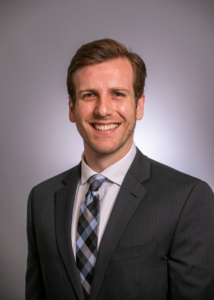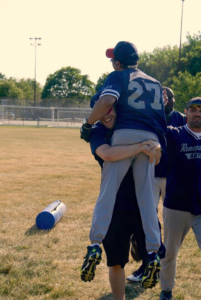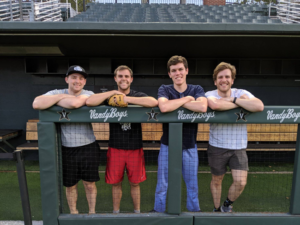Ben Coiner (MD ’22) goes to bat for VUSM students
Future pathologist Benjamin Coiner (MD ’22) offers mentorship, reflections before his next adventure
by Lexie Little
 As the sun beamed down on the red dust of a Boston baseball field in 2015, a rhythmic clamor moved in doppler effect toward home plate. The beeps grew in pitch and volume. A swing. A miss.
As the sun beamed down on the red dust of a Boston baseball field in 2015, a rhythmic clamor moved in doppler effect toward home plate. The beeps grew in pitch and volume. A swing. A miss.
“Coach Coiner, you played collegiate baseball. What advice can you offer about that swing?” a fellow coach asked.
Benjamin Coiner – at the time a recent graduate of the University of Chicago and former catcher for the Maroons – stood baffled for a moment, not confounded by the learning curve that came with beep baseball but by a call for leadership he had yet to experience.
In the Functional Neuroimaging Lab at Brigham and Women’s Hospital, he served as the most junior research assistant following his specialization in neuroscience. Through his educational career studying biology and biological sciences, he had always been the student looking to learn from senior scholars. And as a baseball player, he had always been the developing athlete reliant on coaches and teammates to grow his skills.
But standing on the baseline, athletes who were blind or visually impaired listened for his instruction.
“That was the first time I had really seen myself in a teaching, coaching, leadership role,” Coiner said. “I had always been the lowest in training hierarchies up until that point. I was one of the few people who played collegiate baseball, and they would ask me what I thought about the game. I thought, ‘Wow, I’m one of the more senior consultants on the field.’ It was fun to be one of the experts in the room. Reflecting on that experience, it made me more apt to enjoy a mentoring or teaching role.”
 Coiner joined the Boston Renegades Beep Baseball staff after conducting a Google search for sport connections in his new city where he knew no one. He helped to lead weekly practices, games, and travel matchups, including international competitions in Iowa and Florida. The game came with a learning curve as a sighted coach.
Coiner joined the Boston Renegades Beep Baseball staff after conducting a Google search for sport connections in his new city where he knew no one. He helped to lead weekly practices, games, and travel matchups, including international competitions in Iowa and Florida. The game came with a learning curve as a sighted coach.
“It was a unique and rewarding chance to take a deep dive into others’ experiences and to find how I, somebody with some set of skills, could help,” he said. “Anything from driving people to and from practice to being on the team. Sighted coaches and volunteers help with practice but are also involved with the game play. It was an awesome opportunity to create a space, promote a game, built for that community. It’s funny as a sighted person when you try to play it because everyone is blindfolded to take vision completely out of the picture. When coaches try to do it, we’re so bad. Think about running full speed blindfolded.”
Sometimes, coaches need to learn from the perspectives of their players to better teach. This lesson Coiner learned as a baseball coach now informs his mentorship as a Student as Teacher at Vanderbilt University School of Medicine (VUSM).
From coach to student
 Stadiums dot the map on Coiner’s path to VUSM: Progressive Field in Cleveland, Guaranteed Rate Field and Wrigley Field in Chicago, and Fenway Park in Boston. But now, he and his friends live just down the road from Vanderbilt Stadium and Charles Hawkins Field, where they’ve watched the Vandy Boys on the road to the College World Series.
Stadiums dot the map on Coiner’s path to VUSM: Progressive Field in Cleveland, Guaranteed Rate Field and Wrigley Field in Chicago, and Fenway Park in Boston. But now, he and his friends live just down the road from Vanderbilt Stadium and Charles Hawkins Field, where they’ve watched the Vandy Boys on the road to the College World Series.
No longer a coach, Coiner spectated as a student, one now seeking to match into pathology this spring. He brought life lessons learned from coaching and research in Boston to VUSM.
“[Beep baseball] helped me experience how conditions I will study as a pathologist affect people in their day-to-day lives and how as somebody on the outside can better understand how you can offer something for that group of people,” he said.
When he arrived in Nashville, he thought he might continue to pursue interests in neuroscience and related fields like psychiatry or radiology. But early lectures from pathology faculty during the first-year curriculum piqued his interest in studying disease.
“I came into med school thinking I would go into something that was more related to the research I was doing at Brigham and Women’s,” he said. “But a lot of the great pathology lectures in first year, anatomy lab – that content – got me a lot more excited about maybe doing that…The neuroscience side has more of a pathology component that I would like to look into. Neuropathology uses a lot of imaging, and I could work a lot with neuroradiologists and neurosurgeons in tumor board conferences or interdisciplinary explorations. To be in pathology, I could still get to do some of that neuro analysis. That was a nice foray into a subspecialist view of medicine.”
According to a study published in JAMA Network Open in 2019, the number of active pathologists in the U.S. decreased by 17.5% between 2007 and 2017. In an ever-important but dwindling field, Coiner hopes to encourage others to pursue the study of disease.
“In a backwards way, I feel some pressure to give pathology a good name. Not many students go into it. It’s been me, someone else in my class, and one other person since I’ve been in medical school,” he said. “So, I want people to have a good experience with this content…I’m somewhere between concern about the nuts and bolts of teaching and the greater implications of being a good representative for the content and the specialty.”
Student as teacher
More senior students at VUSM often participate in the Students as Teachers elective through which they mentor first- and some second- year students. M3 and M4 students gain pedagogical skills and put them into practice, integrating a different perspective of academic medicine into their careers at an early stage.
First-year student Niketna Vivek and members of her cohort gain valuable insights through Coiner’s lectures as he acts as an interpreter from student and faculty perspectives.
“Ben has been an amazing resource and mentor,” Vivek said. “His pathology reviews have always been very comprehensive. He does an excellent job explaining specific findings. He also includes slides on topics that we will cover in the future so that when we go back to review for the final, we have a complete slide set to look at. Many of my friends have reached out to him for additional tutoring, and he has even helped a few groups in anatomy lab.
“[He] always goes above and beyond to help students. He is so quick to respond to questions over text. Many students feel comfortable asking Ben questions over text because he always welcomes them and provides helpful insight. When he sees the M1s around [Eskind Biomedical Library] he always stops to say hello and chat. His friendly helpful demeanor and vast knowledge base helps us all learn the content much better.”
Student-teachers offer unique ideas about synthesizing the curriculum based on a mix of their recent studies and clinical experiences, translating the two spaces as “liaisons in both worlds.”
Coiner wanted the opportunity to connect with the broader community in some way at a time when communication remained hindered by the COVID-19 pandemic. Teaching sessions on Zoom and now in person afforded him the opportunity to meet first-year students and explore teaching to see if he liked pedagogy.
“I decided I was going to go into pathology early, midway through my second year when I did a rotation and started comparing it to other specialties,” Coiner said. “Knowing that teaching is such a big part of that career path option, I thought I should try it out – see if I like it or not. That way, I could at least have an informed reason for staying at an academic medical center or learning how to carve out a career if I would want to stay in this field. I wanted to see if I am going to be somebody that could decide between all teaching, some teaching, and explore those different options…Honestly, it’s also been a great way to review some of the stuff I should have learned that I’d forgotten every day.”
Learning and growing
Flipping on fluorescent lights and technology in a second-floor classroom, Coiner looks at the projector. The projector is his new pitcher, throwing light toward the screen. Just as he could inform his coaching based on experience and knowledge in a batter’s box, Coiner informs his teaching by clinical experience and information gained during his studies. Teaching from the perspective of a student, he finds new ways to communicate ideas as his slides flash on the screen.
“If people are coming to my sessions, I want them to be more than just regurgitation of the lectures. I want to offer something that is, at worst, an effective paring down of all the extraneous details to say, ‘Here’s what’s important, and if you just learn this, you’ll be okay,’” he said. “At best, I think I’ve put together some cool little resources when I had more time or big summary review slides, or even big-picture ideas in ways to address things that I struggled with in first year and topics with so much information that would be impossible to cover at once.
“I think, ‘How do I wish this grand topic had been presented and what information did I need to wrap my brain around this concept. That’s been a challenge to doing a good job, to put it simply. I think the lecturers here do a great job, period, especially with a lot of the pathology topics. So, it’s been challenging to find a new way or effective way to get across information in an hour or two. It’s a challenge in a rewarding way, though. It might take me 10-12 hours to get through writing a one-hour presentation, but I feel good about it, and I hope others do, too.”
Coiner’s determination and grit earned the attention of not only his students but of faculty members who have acted as his mentors.
Dr. Jennifer Gordetsky, director of the Division of Anatomic Pathology at Vanderbilt University Medical Center (VUMC) and surgical pathology medical director, said Coiner excelled in his surgical pathology rotation, displaying enthusiasm for the field and picking up information quickly.
“What I find most impressive about Ben is his approach to the challenges he takes on,” Gordetsky said. “He doesn’t over-think things or get caught up in the stress of learning something new, he just takes a thoughtful approach and then gets it done. Ben is a ‘get it done’ kind of person, and that is a great thing to have in medicine.”
Gordetsky and Coiner collaborated on research projects involving genitourinary pathology, a subspecialty of surgical pathology that includes the diagnosis and characterization of disease in the urinary and reproductive systems. Gordetsky said his advanced skills and dedicated research efforts have led to two publications in peer-reviewed literature.
As a student, teacher, and researcher, Coiner will continue lifelong learning as a pathologist. As diseases and medicine evolve, so will his journey as an MD.
His final pitches
Preparing to graduate from VUSM, Coiner readies himself for final pitches: pitching himself to residency programs, listening to residency directors make their pitches, and working to drive home final lessons to students as to why they should explore pathology. Barring any curveballs, he’ll be a leader in his next arena.
This time with a clear vision of his path.